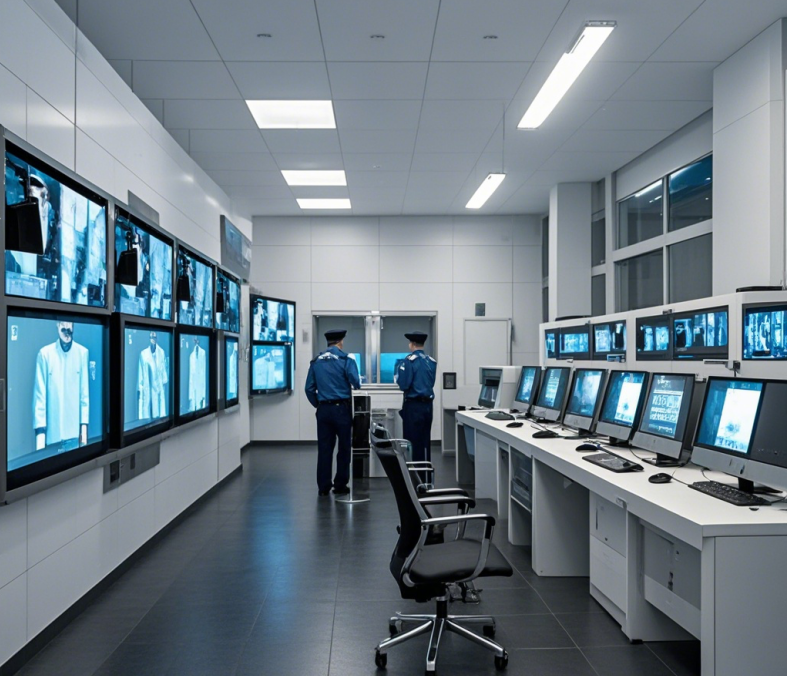Making Wireless IoT Project Easy, Smart, Secure.
GET A FREE SAMPLEThis smart prison solution aims to use UWB high-precision positioning technology to accurately locate prison guards and suspects/criminals inside the prison, in order to improve supervision efficiency, ensure personnel safety, and optimize prison management.

1、 Principles of Positioning System Technology
Hardware equipment
Adopting advanced ultra wideband (UWB) positioning technology, positioning base stations are deployed within the scope of the prison. These base stations will cover various areas of the prison, including cells, corridors, activity areas, workshops, etc. Prison guards and supervised personnel will be equipped with corresponding positioning tags, which will continuously send signals to surrounding base stations.
Precision implementation mechanism
A high-precision time measurement and positioning algorithm based on UWB technology, which accurately calculates the location of personnel by measuring the flight time of signals from tags to multiple base stations. The typical accuracy can reach 10 centimeters, and even in general occlusion, the error can be controlled within a range of<30 centimeters.
2、 Functional modules
Real time personnel positioning and monitoring
The monitoring center can obtain real-time accurate location information of each prison guard and supervised personnel, and visualize it on an electronic map. For prison guards, they can intuitively understand their patrol routes and work positions to ensure the implementation of patrol work. For regulated personnel, their activity trajectory can be monitored in real time to prevent them from leaving the regulatory scope or entering restricted areas.
When personnel approach specific areas (such as prison walls, dangerous equipment, etc.), the system can automatically issue an alarm to remind monitoring personnel to take timely measures.
Action trajectory replay
The system can store and record the historical location data of personnel, and through the query function, it can replay the action trajectory of specific personnel during a certain period of time. This is very useful for event investigation, analysis of violations, and so on. For example, when conflicts or abnormal events occur, the development process of the event can be understood by replaying the trajectories of relevant personnel.
Regional control and alarm
Divide the prison into different security and functional areas, and set corresponding permissions for each area. If the supervised personnel enter the restricted area without authorization, or if the prison guards fail to arrive at the designated area in a timely manner in an emergency situation, the system will trigger an alarm message and notify relevant personnel to handle it.
Personnel statistics and roll call
The system can automatically count the number of personnel in each area and quickly implement the roll call function. Compared to traditional manual roll call methods, it greatly improves efficiency and accuracy. Especially in the case of large-scale personnel management, it is possible to quickly determine whether personnel are complete and promptly detect abnormal situations such as missing personnel.
Emergency response
In case of emergency situations (such as jailbreaks, riots, etc.), the system can quickly determine the location of the personnel involved and provide the best course of action for emergency response personnel to quickly arrive at the scene for handling. At the same time, alerts and instructions can be issued to other personnel through broadcasting, information push, and other means to ensure the safety and order of the entire prison.
3、 System advantages
Improve regulatory efficiency
Through automated personnel positioning and monitoring, the workload and difficulty of manual supervision have been reduced, allowing prison guards to focus more on responding to abnormal situations and performing other important tasks.
Enhance security
High precision positioning and real-time alarm functions can effectively prevent the escape and illegal behavior of supervised personnel, while ensuring the safety of prison guards during the execution of tasks.
Optimize management decisions
Rich personnel location data and action trajectory analysis provide strong support for prison management, helping to develop more scientific and reasonable management strategies and emergency plans.
4、 Implementation steps
Requirement research and planning
Thoroughly understand the layout, personnel size, existing management processes, and security requirements of the prison, and develop detailed project plans and equipment deployment plans.
Hardware installation and debugging
Install positioning base stations within the prison and establish network connections and configurations. Initialize and distribute location tags for prison guards and supervised personnel to ensure the normal operation of the equipment.
Software deployment and integration
Install and configure monitoring management software to integrate the positioning system with the existing security systems in the prison, such as video surveillance systems, access control systems, etc., to achieve data sharing and linkage operations.
Personnel training and system testing
Provide systematic training to prison management personnel and guards on how to use positioning systems for supervision. Conduct comprehensive testing before the system goes live, including precision testing, functional testing, stability testing, etc., to ensure that the system meets design requirements.
Formal operation and maintenance
After the system is officially put into use, establish a comprehensive maintenance mechanism, regularly inspect and maintain hardware equipment, update and optimize software systems, and ensure the long-term stable operation of the system.
Prev:New Engine for Smart Cities: Innovative Applications of Bluetooth Modules Unveiled
Next:The Excellent Application and Value of UWB Modules in the Field of Human Vehicle Positioning Safety
Copyrights© Shenzhen Skylab Co.,LTD All Rights Reserved.

